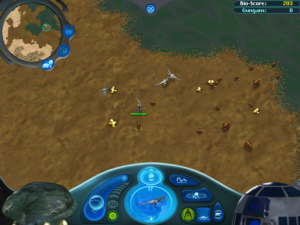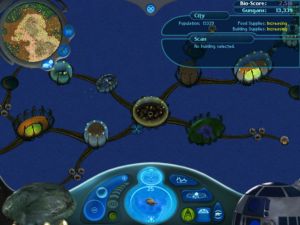The Gungan Frontier: Finished?
Open-ended games present some difficulty for deciding when to remove them from the Stack. The Gungan Frontier at least contains some optional discrete challenges in the form of those training missions, the last couple of which are more like missions that you train for by playing the main game. The penultimate mission asks you to turn around an ecosystem on the verge of collapse due to overharvesting, and get it to the point where it can support a city population of 60000. This would be most easily done by temporarily forbidding all harvesting while you get things into shape, if it weren’t for the stipulation that you lose the mission if the city population ever drops below 5000. I have now managed to pass this test (something I didn’t manage when I first bought the game), but my own best efforts at designing a stable ecosystem from scratch have been a lot closer to the losing end of that range. (Indeed, when I passed the 60k mark in the mission, it wasn’t with a stable ecosystem. Rather, I impatiently gave the city an extra population boom at the end by giving them permission to harvest as much as they wanted of everything, leaving the system in far worse shape than when I started. This is perhaps the grossest violation of the spirit of the game imaginable.)
Anyway, I’ve completed all the explicit challenges in the game, which leaves me with the implicit ones. Creating a stable ecosystem is actually quite easy: all you really have to do is throw in some plants and refrain from overharvesting them. Which raises the question of why you need animals in the system at all. There’s one species of plant that’s carnivorous, and another that supposedly uses an animal to spread its seeds, but for the most part, plants in this game don’t benefit at all from having animals around.
But adding animals to the mix is crucial to exploiting things for the city (in the same way that cows allow us to indirectly eat grass), and also for maximizing your “bio-score”, which seems to take biodiversity into account. But city population and bio-score are just numbers, and even when they’re both far from optimal, Boss Nass will regularly ring you up with effusive congratulations on your success. (I wonder if I can turn him off like Jar Jar? Past a certain point, he’s just as much of a pointless interruption as Jar Jar ever was.) More important, to my mind, is the because-it’s-there factor. The longest possible food chain seems to be five steps, with the Rancor as apex predator. Keeping a five-step chain stable would be a considerable challenge, and thus something one could pursue for its own sake. Then there are some exotic combinations to pursue. I mentioned a carnivorous plant, the Tooke Trap. It can combine with the Shiro, an herbivorous turtle-analogue, to form the Shiro Trap, a bulbasaur-like symbiote: the plant grows on the animal’s back to provide the plant with mobility and the animal with camouflage. Creating a system with a stable Shiro Trap population would require enough set-up that you’d pretty much have to pursue it as an end in itself.
The game contains a total of 85 distinct lifeforms, although the number of species is somewhat less due to multi-stage life cycles: one species of plant has spores that drift about independently, one species of animal lays eggs that you can harvest separately, a couple of animals have young with different diets and predators and terrain access than their parents. If a player really wants a thorough Gungan Frontier experience, there’s plenty of complexity to explore. The game itself contains encyclopedic data about each organism, but it’s not organized in a way conducive to big-picture planning. If I really wanted to delve into it, I’d start by making a chart of all the predator-prey relationships, annotated with observations about how much things eat and how fast they reproduce. (The game is packaged with a poster showing all the species, and I hoped at first that it would be such a chart, like the tech-tree posters often packaged with strategy games. But no, it just shows names and pictures.)
But I don’t think I want to delve into it that deeply. Self-imposed implicit challenges are never a requirement for removing something from the Stack. I’ve spent a significant amount of time fiddling with ecosystems on my own, and that’s all the game can ask from me.
 Comments(1)
Comments(1)
